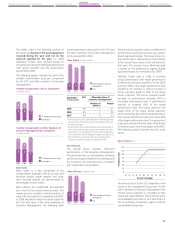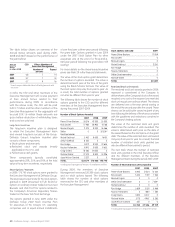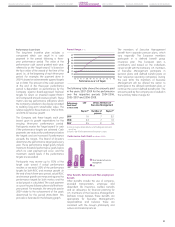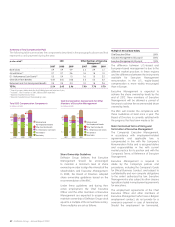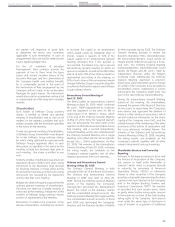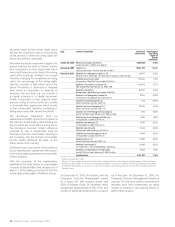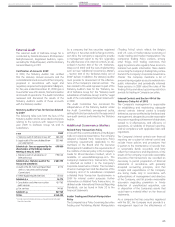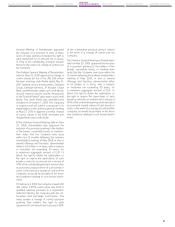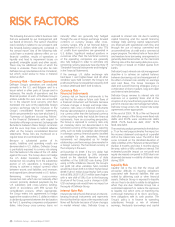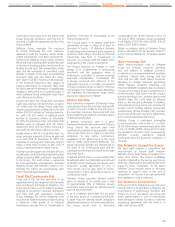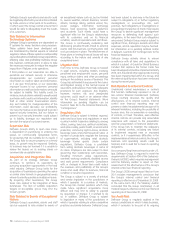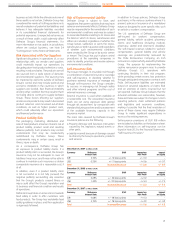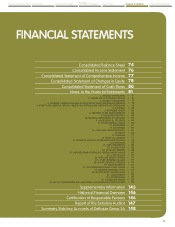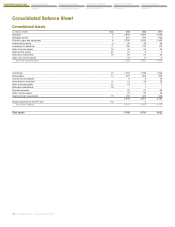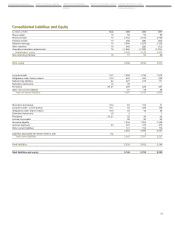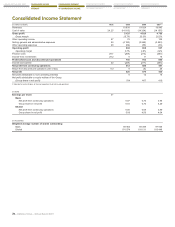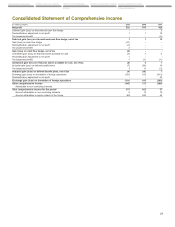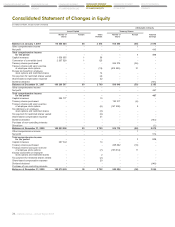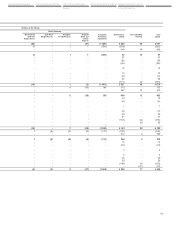Food Lion 2009 Annual Report Download - page 73
Download and view the complete annual report
Please find page 73 of the 2009 Food Lion annual report below. You can navigate through the pages in the report by either clicking on the pages listed below, or by using the keyword search tool below to find specific information within the annual report.
69
contributions and loans from the parent and
Group financing companies, with the aim of
ensuring a balanced repayment profile of the
financial debts.
Delhaize Group manages the exposure
by closely monitoring the cash resources
required to fulfill the working capital needs,
capital expenditures and debt requirements.
Furthermore, Delhaize Group closely monitors
the contractual maturity profiles and the amount
of short-term funding and the mix of short-term
funding to total debt, the composition of total
debt and the availability of committed credit
facilities in relation to the level of outstanding
short-term debt (see also Notes 18.1 ”Long-
term Debt” and 18.2 ”Short-term Borrowings”
in the Financial Statements with respect to
maturity information on long-term debts and
for Debt Covenants information). A liquidity gap
analysis is performed on a quarterly basis in
which Delhaize Group anticipates large future
cash inflows and outflows.
At year-end 2009, the Group had committed
credit lines totaling EUR 622 million, of which
587 million was not utilized. These credit lines
include a syndicated US credit facility of USD 500
million (EUR 347 million) for Delhaize America,
Inc. and EUR 275 million of bilateral credit
facilities for European entities. At December
31, 2009, the maturities of the committed credit
facilities were as followed: EUR 100 million
maturing in 2010, EUR 125 million maturing in
2011 and EUR 397 million maturing in 2012.
As described in Note 18.1 ”Long-term Debt,” no
major principal payment of financial debt will
occur until 2014. At December 31, 2009, the
maturities of the long term debt were EUR 42
million in 2010, EUR 37 million in 2011, EUR 79
million in 2012 and EUR 81 million in 2013.
The financial rating agencies Standard & Poor’s
and Moody’s have attributed investment grade
ratings long term BBB- and Baa3 respectively
to the Group. This credit status is supported
by cross-guarantee arrangements between
Delhaize Group and Delhaize America Inc.,
whereby the entities are guaranteeing each
other’s financial debt obligations.
Credit Risk/Counterparty Risk
Credit risk is the risk that one party to an
agreement will cause a financial loss to another
party by failing to discharge its obligation of a
financial instrument, such as trade receivables,
holdings in investment securities, derivatives
and cash and cash equivalents. Delhaize
Group manages this risk by obtaining credit
insurance for trade receivables and by requiring
a minimum credit quality of its financial
investments (see also Note 11 ”Investments in
Securities” and Note 14 ”Receivables” in the
Financial Statements).
The Group’s policy is to require short-term
investments to have a rating of at least A1
(Standard & Poor’s) / P1 (Moody’s). Delhaize
Group’s long-term investment policy requires a
minimum credit rating of A-/A3 for its financial
investments (see Note 11 ”Investments in
Securities” in connection with the respect to the
credit quality of the Group’s investments).
The Group’s exposure to changes in credit
ratings of its counterparties is continuously
monitored and the aggregate value of
transactions concluded is spread amongst
approved counterparties. Counterparty risk
is always assessed with reference to the
aggregate exposure to a single counterparty
or group of related parties to avoid or minimize
concentration risk. Delhaize Group’s derivatives
are regulated by International Swap Dealer
Association Agreements (”ISDAs”).
Pension Plan Risk
Most operating companies of Delhaize Group
have pension plans, the structures and benefits
of which vary with conditions and practices in
the countries concerned. Pension benefits may
be provided through defined contribution plans
or defined benefit plans.
A defined contribution plan is a post-
employment benefit plan under which Delhaize
Group and/or the associate pays fixed
contributions usually to a separate entity. Under
such a plan, there are no legal or constructive
obligations to pay further contributions,
regardless of the performance of the funds
held to satisfy future benefit payments. The
actual retirement benefits are determined by
the value of the contributions paid and the
subsequent performance of investments made
with these funds.
A defined benefit plan is a post-employment
benefit plan which normally defines an amount
of benefit that an employee will receive upon
retirement, usually dependent on one or
more factors such as age, years of service,
compensation and/or guaranteed returns on
contributions made.
Delhaize Group operates defined benefit
plans at several of its entities and a total
of approximately 20% of Delhaize Group’s
associates were covered by defined benefit
plans at the end of 2009.
If, as of a balance sheet date, the fair value
of the plan assets of a defined benefit plan,
is lower than the defined benefit obligations
(determined based on actuarial assumptions),
the Group would bear a theoretical
”underfunding risk” at that moment in time. At
the end of 2009, Delhaize Group recognized
a net liability of EUR 80 million (2008: EUR 69
million; 2007: EUR 61 million).
Details on pension plans at Delhaize Group
and its subsidiaries can be found in Note 21.1
to the Financial Statements, ”Employee Benefit
Plans.”
Macro-economic Risk
Major macro-economic risks of Delhaize
Group are reduced consumer spending
and cost inflation or deflation. Economic
conditions such as employment level, business
conditions, interest rates, energy and fuel
costs and tax rates could reduce consumer
spending or change consumer purchasing
habits. Weaker consumer spending can
impact profitability negatively due to pressure
on sales and margins. If labor cost and the cost
of merchandise sold, which are the Group’s
primary operating costs, increase above retail
inflation rates, this could have an adverse
effect on the Group’s profitability. In addition,
rising fuel and energy prices can increase the
Group’s cost for heating, lighting, cooling and
transportation. Where possible, cost increases
are recovered through retail price adjustments
and increased operating efficiencies.
Delhaize Group is particularly susceptible
to macroeconomic risks in the U.S. In 2009,
68.3% of the Group’s revenues were generated
in the U.S. (2008: 68.8%), where all of its stores
are located on the East Coast. Consequently,
Delhaize Group’s operations depend
significantly upon the economic conditions in
this area.
Risk Related to Competitive Activity
The food retail industry is competitive and
characterized by narrow profit margins.
Delhaize Group faces heavy competition from
many store chains. The Group’s profitability
could be impacted by the pricing, purchasing,
financing, advertising or promotional decisions
made by these competitors. To the extent
Delhaize Group reduces prices or increases
expenses to support sales in the face of
competition, net income and cash generated
from operations could be affected.
Risk Related to Social Actions
At the end of 2009, Delhaize Group had union
representation in its operations in Belgium, the
Grand-Duchy of Luxembourg, Romania and
Greece. In its U.S. operations, the Group had
union representation in one of Hannaford’s
three distribution centers, for which a collective
bargaining agreement with the union is in
effect until February 2012.
DELHAIZE GROUP AT A GLANCE
OUR STRATEGY OUR ACTIVITIES IN 2009 CORPORATE
GOVERNANCE STATEMENT
RISK FACTORS
FINANCIAL STATEMENTS
SHAREHOLDER INFORMATION


